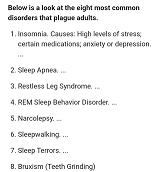
Sleep related problems are reaching epidemic proportions. A lack of sleep can severely compromise both mood and physical performance. Sleep is critical to brain function, influencing cognition, concentration, productivity, and performance. Sleep disturbance research reveals negative impact on brain functioning to a similar degree as alcohol intoxication. According to a study by the North American Association for the Study of Obesity, children and adults with short sleep duration were 89% and 55% more likely to develop obesity, due to sleep’s role in hormonal regulation, exercise motivation, and overall mood. A quick glance at the info-graphic above and you will likely see a statistic that relates to why you are here. Everyday stresses in life, specifically family, career, and relationships are fertile breeding grounds for chronic insomnia; where there’s stress, anxiety follows. Anxiety, or excessive worry and fear, has many layers to it and is directly linked to perceived threats to our ego. The ego talks about itself in recurrent, variations on themes, typically in negative, catastrophic ways, with resulting anxiety. These unresolved issues get embedded in our sleep and dreams for further processing. The processed and regurgitated content is re-introduced in our waking lives as ruminations and hunches. Anxiety and it’s related ‘issues’, in reality, is created from three distinct unconscious levels. The highest and pre-conscious level of anxiety concerns itself with disowned or poorly integrated aspects and meanings about ourselves and the world. This content typically presents itself as snippets and snatches of dreams and gut feelings we have upon awakening. The second level of dream related anxiety occurs in our subconscious mind and involves repressed traumatic content infused at it’s core, with our most primal emotions (shame, revulsion, rage, terror). The event, with it’s imagery and overwhelming emotions is expressed at this level in symbolic form. The symbolic and primal emotional nature of this content is repressed due to it’s threat against our core identity and borrows it’s energy from the third level of our unconscious mind. The third and deepest level of dream related anxiety exists in our bodies as imprinted physical traumas (birth, car accidents, surgeries, assaults, etc.) and has it’s origins in situations endangering life, health, and the integrity of the body. Chief among these threats to our bodies, are confining/claustrophobic events that create the theme of suffocation. These imprints can be displayed in our posture, muscle guarding, auto-immune diseases, and a host of other habitual, physiological dysfunctions. All three levels are presented as compressed layers, both in our subconscious and waking state, in thematic fashion. In the nucleus of each theme lies a common tone of emotional and physical sensations. Anxiety plays a major role in the following sleep disorders.

What then does therapy focus on and how do we avoid being a statistic? Treatment focuses on mind and body and has as it’s goals, the processing of unconscious material and release of emotional and physical imprints. Through the use of behavioral interventions, mental strategies, insight and relaxation techniques, combined with experiential processing of non-ordinary states, clients can reclaim their sleep and conquer anxiety.
